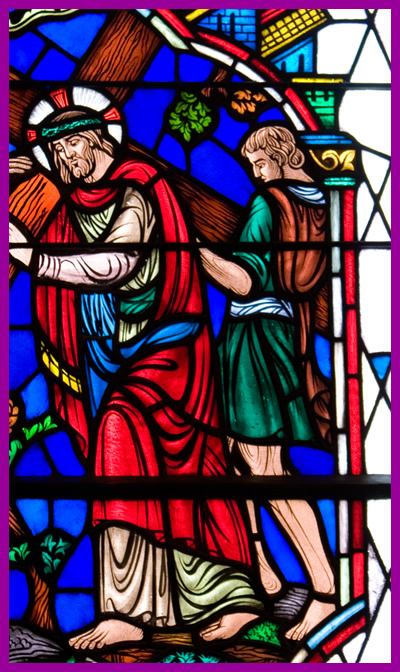I�d like to begin this week�s post by addressing a statement issued this week by the Massachusetts Catholic Conference.
Last week Gov. Deval Patrick made what we consider to be an unfortunate statement on stem-cell research and the bishops of Massachusetts thought that we best try to clarify. We published a statement April 3 in which we articulated the Catholic Church�s stand on stem-cell research and emphasized that we are very much in favor of scientific investigation. As Church, we would, of course, like to have cures found for all kinds of diseases. However, ethical considerations always have to be a part of what we do in the area of science. Science has progressed very, very rapidly but ethical thinking � what is moral what is proper � requires reflection. It also requires a commitment to do what is respectful of the dignity of human life.
So in our statement we are urging our governor to support research that is respectful of the ethical questions at hand. We also called Gov. Patrick�s attention to the fact that successful research to date has come exclusively from umbilical cord and adult stem cells. Unfortunately, there seems to be a tendency to invest our resources in unethical areas that have not been scientifically fruitful, such as embryonic stem-cell research. However, it is the ethically sound areas of research that have produced cures, and our resources should be invested in those areas.
When the media promote embryonic stem-cell research, they often give the impression that those who oppose it are some sort of religious fanatics. They make it sound as if those who oppose such research are completely indifferent to discovering scientific cures. In actuality, the scientific cures are coming about through the ethical ways of doing things, and we are simply asking that resources be used to further the wonderful work that is respectful of who we are as human beings.
Here is the text of the statement issued jointly by the four ordinaries (diocesan bishops) of Massachusetts:
The Governor of Massachusetts announced recently his commitment to encouraging Massachusetts scientists, possibly with the use of public funds, to create human life in the laboratory, and then to destroy the embryos for �humanitarian� research purposes. He characterized objections to this research as �ideological politics� and stated that �I want science to prevail.�
The Governor minimizes the profound moral concerns at stake and attributes to science the exclusive authority to determine right and wrong. History has demonstrated that science must be governed by ethical principles rooted in the fundamental values of human dignity and sanctity of human life or it will become the engine of great destruction. Destroying human life is never humanitarian. Nor is the taking of human life necessary in the fight to find cures. Research and therapies using placental and adult stem cells continue to meet with great success without ethical cost. This is the direction that the �life sciences� should pursue.
We oppose the expansion of, and the use of taxpayer money for, any research that destroys human life. The use of public funding for unethical research that has not produced a single clinical benefit is a misuse of public monies. We call on the Governor to refrain from promoting any such policies as they are utterly inconsistent with good science and human dignity.
We encourage the Governor to support stem cell research which respects the innate dignity of human life. Remarkable achievements have been attained by using ethical sources of stem cells, including umbilical cord blood, placental tissue and adult cells. We support stem cell research that does not endanger human life, is carried out in an ethical manner, and has been demonstrated to be effective.
A couple of years ago, the US Conference of Catholic Bishops published the following two beautiful ads explaining the Church’s position on stem cell research. I like both, but the one about Joshua who was an embryo 270 days ago is particularly striking.
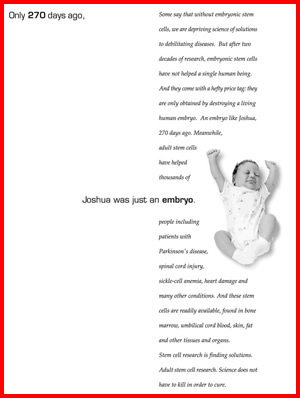
Click here to see the enlarged version
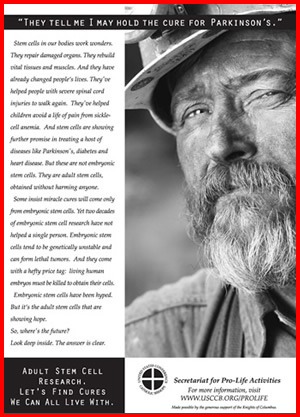
Click here to see the enlarged version
– – –
On Palm Sunday I visited two parishes in the inner-city neighborhoods in Boston to speak with the parishioners about the violence in our city. The city of Boston is facing a very serious crisis. Violence in the inner-city streets is greatly escalating. It is a great source of anxiety for all of us, particularly when we see young people being wantonly murdered even in broad daylight. It is sad that there are so many weapons out there and so little respect for human life.
At St. Katharine Drexel Parish in Roxbury, I spoke at the end of the homily and at St. Peter Parish in Dorchester after communion. I had actually been visiting Father Walter Waldron in St. Patrick’s in Roxbury the night before, who is doing such a wonderful job in the inner city.
I told the Catholics at both parishes that on Palm Sunday, Christ went into the city even though it was dangerous. In the middle of the danger, Christ wants to be with us. The violence comes from the unbridled individualism of our age and is a result of the philosophy of life in a culture that is addicted to entertainment. Very often, entertainment means violence, sex and drugs. As Christians, we are trying to build a civilization of love where people are responsible for one another and have concern for their fellow man. What we do to build strong communities is the antidote to that violence. I just wanted to thank them for being part of their parishes and encourage them to make their parish communities stronger. That is the way to strengthen family life and to make the community safer for everyone.
– – –
I celebrated a Mass for Palm Sunday at Father John Unni�s parish, St. Cecilia�s in Boston. The church was filled with university students. They served the Mass, sang and were lectors and musicians. Many of them are music majors, and the liturgy was very, very beautiful. They are such a wonderful resource for a parish, and obviously, it is the kind of community that young people gravitate toward. It is a beautiful church and a wonderful setting for them. I was happy to begin Holy Week there.
Sadly, there were two students who just in the previous days had died in accidents, so many of the students were very distressed by that and certainly were looking at the Church for consolation in that moment. It was good for them to be able to come and pray with the other students.
As I always find, the ministry at the college campuses is something that is such an important part of what we do as a diocese. We are helping these young adults as they are preparing themselves for life as well as helping them to have a relationship with the Lord and with the Church. So I have always been very happy for the opportunity to celebrate Mass with the students.
– – –
At the Chrism Mass on Tuesday, I was very grateful to see so many brother priests attending, this year we had about 400. The Chrism Mass is a special time for us to renew our priestly vows and commitment to our ministry.
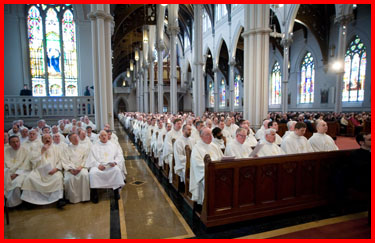
There were also many school children from several parish schools around the archdiocese.
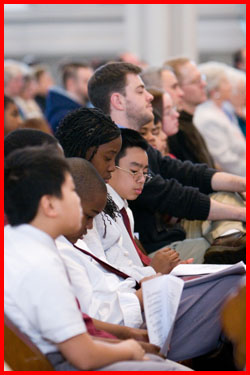
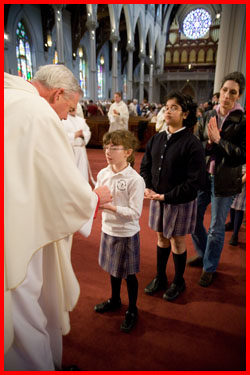
Each year at the Chrism Mass we bless the oils that will be used throughout the coming year. There are three types of oil that are blessed � the oil for catechumens, for anointing the sick and the chrism. The chrism oil is used in those sacraments which are received only once � baptism, confirmation and ordination. Balsam is added to the chrism and then stirred in so that the oil will be fragrant. It is a way that they make the chrism special because it is the oil that consecrates. The very word Christian comes from the word for �the anointed� and �Christos� or �Christ� means �the anointed one.� That was the Messiah. The anointing that we celebrate in our sacraments are signs of a spiritual strengthening.
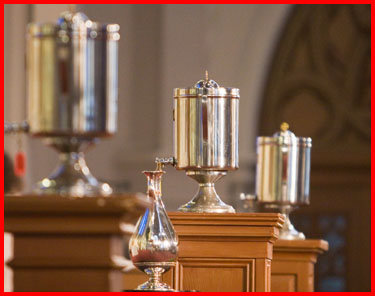
The vessels containing the oil of the sick, the chrism and
the oil of catechumens. The smaller vessel, below the others
contains the balsam to be added to the chrism
�
We also were very happy to have Metropolitan Methodios joining us, as he does every year, at the Chrism Mass. At the beginning of the Mass, he greets the priests and the people of the archdiocese. Then at their Easter Vigil, I usually go and greet our Orthodox brothers and sisters. And the metropolitan was very happy to announce the joint Catholic-Orthodox pilgrimage that will take place next September with visits to Rome and to Constantinople. We have a very close relationship with the Greek Orthodox, and we pray that will lead to greater unity between our churches.
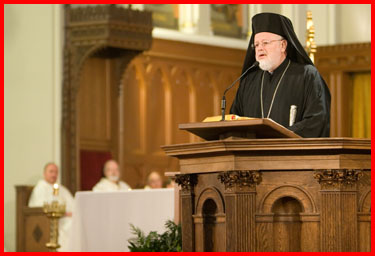
Metropolitan Methodios addresses the assembly
The theme of the homily was the priest as the servant of Christ, the suffering servant. Last year I reflected on the priest as father or shepherd. This year we looked at the Isaiah reading that Christ quotes in his inaugural sermon and reflected on that in the life of a priest.
There are 100 Jesuit priests living in St. Mary�s Hall. It must be one of the largest religious houses in the world. I call Father Paul Harmon the Father Abbott, though not many abbots have that many monks. Father Harmon has 100 Jesuits waiting in him hand and foot.
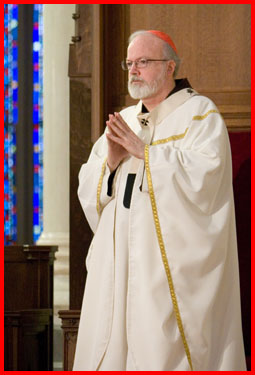
For a while the largest community of priests in modern time was the Pfarrerblock. It was the priest section of the concentration camp at Dachau. There were a cardinal, bishops, and about 3000 Catholic priests there, in addition to some 100 Protestant clergy and 30 Orthodox priests. Many did not survive the ordeal. In 1975 I participated in a Mass in St. Peter�s with Cardinal Wright and several hundred priests who were survivors of concentration camps. It was one of the most moving experiences of my life. Cardinal Wright often cited the sociological studies done about the concentration camps. The researchers interviewed survivors: Jews, intellectuals, political prisoners, from Italy, France, Germany, Hungary, Poland. All were asked: In the midst of the hell that was the concentration camp, surrounded by all the horror rife in those prisons, horrors that depersonalized, destroyed personality and sanity as well as health, what group remained sane the longest? What group remained useful the longest? What group retained their sense of identity the longest? What people were the last to suffer the crisis about why they were alive, or who they were or what was their task? What group, what nationality, what profession, what race was most able to forget themselves and their problems so they could serve the others who had the same problems? The answer was almost invariable: the Catholic priests.
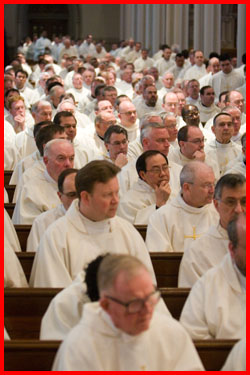
One of the inmates of the Pfarrerblock at Dachau was a priest from Luxembourg who kept a diary documenting the torture of the priests. The Nazis crucified priests and crowned them with barbed wire. In 2004, a German film director got a hold of the diary and produced a film called Der Neunte Tag (The Ninth Day). The protagonist is a Luxembourg priest, Abbe Kremer, who had been imprisoned for being part of the resistance movement in his country.

One of the most powerful scenes in the film is the Mass the emaciated priests celebrate clandestinely using a crust of bread. Abbe Kremer is promised his freedom if he will cooperate with the Nazis. There are very tense conversations with an SS office, Officer Gebhardt, who had been in the seminary but had long since renounced his faith. At one point Gebhardt says, �It was my mother�s fondest wish that I become a priest, so as to have a dignitary in the family.� Father Kremer answers, �Priests are servants, not dignitaries. My mother knew that.�
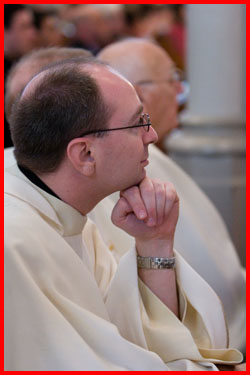
I was very struck by that phrase, because many people do consider the priest a dignitary. The increasing role of the laity, the fall out of the sexual abuse scandal, the secularization of the culture have all caused people to see the priest differently. And yet many still think of priests as dignitaries. All the same, Abbe Kremer and his mother Madame Kremer knew that the priest is not a dignitary, but is a servant like Jesus is a servant. The more we understand Jesus� identity, the more we will understand our own.
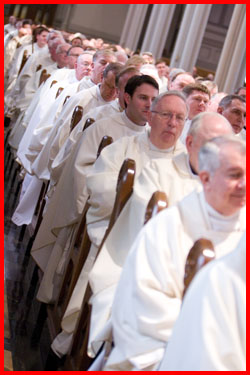
In today�s Gospel, Luke details the beginning of Jesus� ministry. This periscope is prefaced with the phrase �He began to teach� � this is the way Christ�s ministry begins. The account of Jesus� first sermon in the synagogue opens with Jesus choosing the text of Isaiah. For Jesus nothing is improvised, nothing is a coincidence. Isaiah is the great prophet of the Messiah. He speaks of the Virgin who will conceive a son, Emmanuel, God with us. Isaiah describes for us the suffering servant. When people read Isaiah 53 without knowing which part of the Bible it comes from, they often wrongly assume it is from the New Testament. One author claims there are 121 passages in Isaiah that describe Jesus. In today�s lessons, Isaiah speaks of the servant who is anointed � the Christos, the Messiah � by the Spirit. He goes on to describe Christ�s mission; to announce the Good News to the poor, restore sight to the blind, to free the captive and the oppressed, to declare a Jubilee. And just to make sure that we did not miss the point, Jesus says: �Today this Scripture is fulfilled in your hearing.� Jesus is the Messiah, the Suffering Servant, the Wounded Healer.
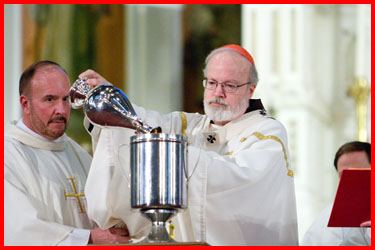
Adding the balsam to the chrism
�
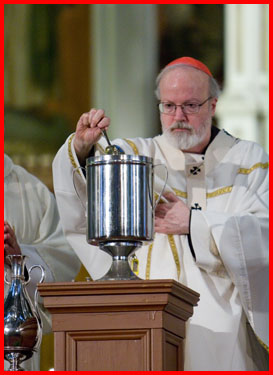
Stirring in the balsam
�
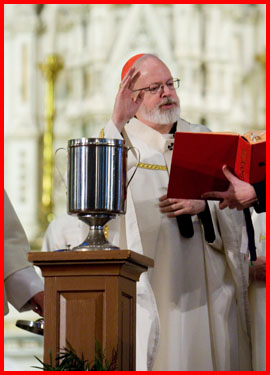
Blessing the chrism
This is the same Christ of whom John writes in today�s reading from Revelation, �He loves us, He has freed us from our sins, He has made us priests�. He has made us priest because He loves us, not because we are good looking, clever or holy, but because He loves us. John goes on to say: �Behold He is coming amid the clouds, and every eye shall see Him, even those who pierced Him.� We behold the one who was pierced. The Risen Lord is still the Suffering Servant, still the wounded Christ. That is why the Risen Lord is so quick to show His wounded hands when he appears to the first priests and says, �Receive the Holy Spirit, whose sins you shall forgive they are forgiven them.� This Suffering Servant loves us and is patient with us: �A bruised reed He will not break, and a smoldering wick He will not snuff out.�
Today�s Gospel from the fourth chapter of Luke depicts for us the inauguration of Jesus� public ministry. Placing this scene first is an important interpretive move for it suggests that the rest of the Lukan story (the Acts as well as the Gospel) should be read in light of this scene. By citing the Prophet Isaiah, Jesus is providing us an interpretation of His ministry. The descent of the Spirit is an anointing for office. Anointed with the Spirit, Jesus is the Messiah, the Christos, the King of Israel, but His immediate function is prophetic: He is to be the bearer of the Good News.
In Luke especially we see the poor as the protagonists of the Gospel. The Suffering Servant is close to those who are poor, marginalized, sick, and forgotten. When Jesus speaks about �the release of captives� this can also refer to Jesus� ministry of reconciliation, the forgiveness of sins. Recovery of sight to the blind refers to Jesus� healing power but also to His teaching role that helps people to understand revelation and to see by the light of faith. It is as though Isaiah has written the job description for the Messiah, the Suffering Servant.
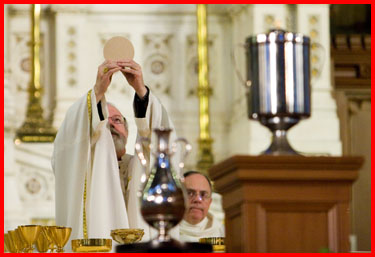
When Jesus called His apostles in the Gospel, He said, �Follow me�. He didn�t say, �How would you like to be suffering servants?� That would be like the Irish marriage proposal, �How would you like to be buried with my people?� But when the apostles were still thinking they were going to be dignitaries, two of them went with their mother to ask for thrones at Jesus� left and right. Jesus responds by asking that terrible question, �Can you drink of the chalice that I am going to drink?� They responded, �We can�. I am sure they had no idea what they were saying.
When we were ordained, the ceremony began with an invitation, �Let those who are to be ordained come forward�. We responded blithely, �Adsum � Present!� Did we have any idea what we were saying? Like the apostles, we answered with na�ve enthusiasm. Like a young man making his marriage vows; for better, for worse, for richer, for poorer, in sickness and in health, all the while looking forward to the better, the richer, the good health.
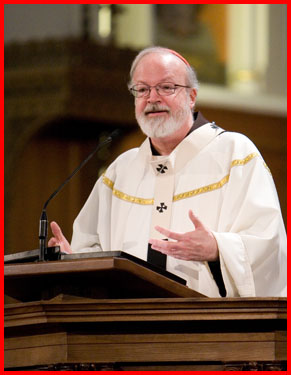
Can you drink of the chalice of the Suffering Servant by whose stripes we are healed? Like the sons of Zebedee, we said �Adsum, possumus, we can�. We had no way of knowing that we were being called to be priests in the most challenging time in the history of the Church in our country. Looking back on my days in the West Indies when a hurricane flattened most of our churches, schools and rectories, I recall that we survived on coconut milk and peanut butter and were without water, phones or electricity for six months, a year without television (that was a blessing). What could be worse than this, I thought at that time. Having experienced our recent crisis, I say, �Give me a good hurricane any day!�
None of us knew what we were getting into when Christ said, �Follow me.� We had only a vague notion that the path might lead to Calvary. We knew in theory. Living it is different.
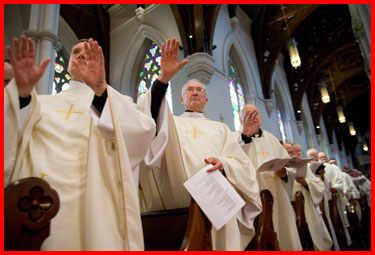
My brother priests extend their hands as I bless the chrism
It is not by accident that one of the symbols of the Catholic priesthood is the chalice. I always felt a little sad that as a Capuchin I could not have my own chalice. I would like to have taken my uncle�s, Father Jerry Reidy, the diocesan priest who baptized me, or have a replica of the O�Malley chalice that is in the museum in Dublin. But the chalice is not a trophy. In the National ordination ceremony the Bishop handed us the chalice and paten and said: �Receive the oblation of the holy people to be offered to God. Understand what you do, imitate what you celebrate, conform your life to the mystery of the Lord�s Cross.� �Agnoscite quod agitis, imitamini quod tractatis.�
The fear of the Cross is what makes us mediocre. The fear of suffering. When Jesus prayed, �Let this chalice pass from me, but not my will but thine be done�, Peter was watching and listening, but when the soldiers came the apostles fled, even the ones who said, �we can drink of the chalice�. They ran. Peter tried to follow Jesus at a safe distance. That didn�t work. In the attempt he denied his master three times. It is impossible to follow Jesus at a safe distance. We need to follow Him up close. Later, the Risen Christ will ask Peter, and all His priests, �Do you love me?� �Yes, Lord, you know that I love you.� �Feed my sheep�. A few weeks later after that conversation, St. Luke depicts the apostles, including Peter, who have been flogged and beaten for their preaching, for feeding the sheep. They were told not to speak about Jesus and were dismissed. �So they left the presence of the Sanhedrin rejoicing that they were counted worthy to suffer dishonor for the name of Jesus. And all day long, both in the temple and in their homes, they did not stop teaching and proclaiming the Messiah, Jesus.� They drank form the chalice of suffering and fed the flock of Christ.
We are afraid of the Cross. These last weeks of Lent, praying the Stations I always identify with Simon the Cyrenean. He was pressed into service. He was embarrassed to be part of an execution, angry because he was innocent and forced to be part of a spectacle. He was afraid of what damage would be done to his standing in the community, in his family. I like to think that later Simon the Cyrenean looked back on that horrific experience of carrying Christ�s cross up Mount Calvary through a hostile crowd as the defining moment in his life. His sons, Rufus and Alexander, surface in Acts and Mark and the Epistles. He must have embraced the faith and passed it to his family. Still his hesitancy contrasts with the spontaneous and courageous gesture of compassion of Veronica. She overcame fear and drew near to Christ.
As priests we must overcome our fears: of suffering, of failure, of shame, of sickness, of death, of being alone. Only love can cast out all these fears. Today the High Priest, Good Shepherd and Suffering Servant offers us the cup to drink. Father Henri Nouwen said, �Drinking the cup that Jesus drinks is living a life in and with the spirit of Jesus which is the spirit of unconditional love. The intimacy between Jesus and Abba, His Father, is an intimacy of complete trust, in which there are no power games, no mutually agreed upon promises, no advance guarantees. It is only love, pure, unrestrained and unlimited love.�That intimacy gave Jesus the strength to drink His cup. That same intimacy Jesus wants to give to us so that we can drink ours. That intimacy has a name, a Divine Name. It is called the Holy Spirit. Living a spiritual life is living a life in which the Holy Spirit will guide us and give us the strength and courage to keep saying �yes� to the great questions, �Can you drink the cup? Do you love me?�
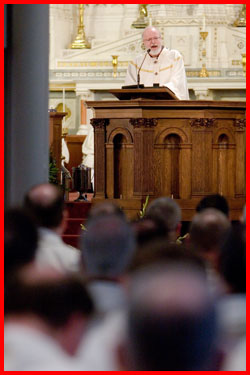
Today Jesus is telling us not to carry the Cross like the Cyrenean, through fear and compulsion. Follow the Master up close, do not fear the chalice, do not fear the Cross. Fear only not loving enough, that is the only real tragedy. The only real failure in the priesthood of Jesus Christ is not loving enough.
At the first Eucharist the Lord washes the feet of His disciples to give us an example, to teach us to be servants. He gives us a new commandment to love one another as He loves us. His total and sacrificial love must be the measuring stick for the love and unity, the communion that binds us together. Then He gives us the sacramentum caritatis, the sacrament of love where, as His disciples, we will find the nourishment to love as He commands us. We are the vessels of clay that carry these treasures for God�s people.
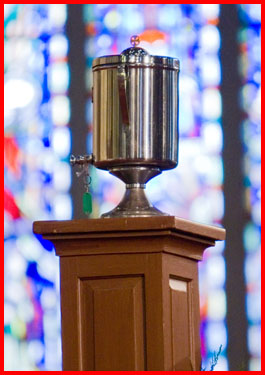
Let us strive to live as His priests, servants of the Suffering Servant, who grasp the chalice firmly each day, who know what we are doing, who imitate what we handle, who conform our lives to His Cross. Let us never forget Jesus� words: �The Son of Man came not to be served but to serve, and to give His life as a ransom for many.� In giving your lives you are part of the ransom.
– – –
Following the Mass, many of the priests came to St. John�s Seminary for lunch, and two priests were honored by a committee of their peers and presented with a crucifix. Both priests are very much admired.
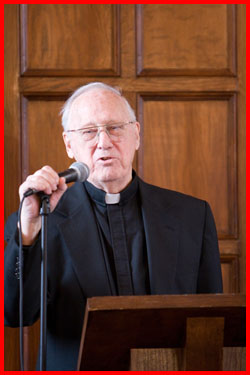
Father Moritz speaks about the joys of being priest
The first was Msgr. Paul Moritz who is 96 years old and has been a priest for 65 years. He was a priest before I was born! What�s more, he is still active, still going out and celebrating Masses. He gave a wonderful testimony about how happy he is to be a priest and how wonderful the ministry of the last 65 years has been.
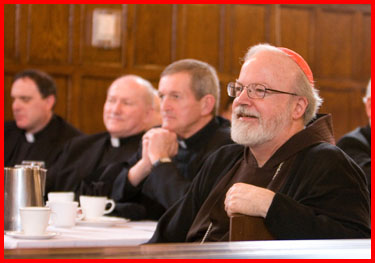
His witness was truly inspiring
The other priest who was singled out was Father Jim Ronan, who had worked in the missions in Ecuador through the Missionary Society of St. James the Apostle. The society was founded 49 years ago by Cardinal Richard Cushing in response to Pope John XXIII calling priests and religious from North America to aid the faithful of South America. Father Ronan had also run the Latin America secretariat of the U.S. Bishops Conference for a few years. He has been a pastor in Lawrence and Charlestown, where he has had challenging responsibilities of bringing communities together. He has done such a wonderful job.
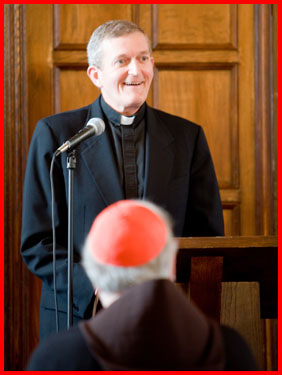
Listening to Father Ronan
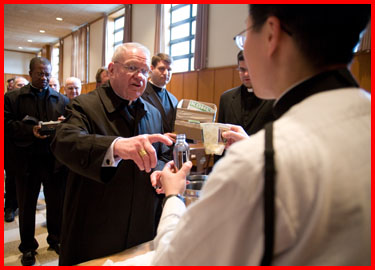
Before the Chrism Mass luncheon the oil that was blessed
is distributed for use throughout the year.
Here Bishop Edyvean asks a seminarian to fill a vessel with chrism
�
– – –
On Wednesday night we celebrated Tenebrae, which is essentially a celebration of the Liturgy of the Hours.
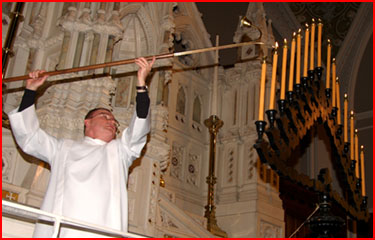
Lighting the candles on the Tenebrae hearse
The liturgical documents suggest that during Holy Week there should be a public recitation of the hours in the cathedral. I thought a very good way to do that and to get a larger number of people is to re-institute the practice of Tenebrae, which adds a little bit of drama to the event. It is a beautiful and ancient service, which basically is the praying of the psalms and the chanting of the lamentations from the Old Testament. Then we also chant the Benedictus from lauds of Holy Thursday. We have the candelabra called the hearse, and after each of the psalms, another candle is extinguished until only the last candle, Christ�s candle, remains. Father Sean Connors did a wonderful job preaching at the service.

Tenebrae means �darkness� in Latin, and the service ends with the �Strepitus,� a rumbling of the organ that resembles the banging of breviaries or the sounds of the earthquake mentioned in Scriptures or the people rushing. There are many different interpretations of what it means. I think it sets the mood for Holy Week, which is penitential and reflective.
Click here to watch a few moments of the final part of the Tenebrae, including the Strepitus played by Leo Abbott, our music director at the Cathedral
– – –
In next week�s blog we plan to include photos and commentary from the Paschal Triduum that will culminate with the Easter Vigil that I will celebrate at the Cathedral Saturday evening. But before I conclude this week�s posting, I want to share with you an urgent call for help from Catholic Charities.
A few weeks ago, Catholic Charities appealed to the community for donations to help provide food for our neighbors in need. Through the agency�s food pantries and other food assistance programs, many who are struggling to make ends meet receive the support they need to provide the basic necessities of life.
These are just a few of the programs sponsored by Catholic Charities in the name of the Church. Overall, the agency provides approximately 140 programs and services in 40 locations throughout Eastern Massachusetts. Services respond to the needs of the poor and working poor, support children and families, and assist refugees and immigrants. Each year, Catholic Charities serves nearly 200,000 people in need fulfilling its mission of building a just and compassionate society rooted in the dignity of all people. In all of these good works Catholic Charities responds to Jesus� call given to us in Matthew 25: �Whatever you did for one of these least brothers of mine, you did for me.�
The Easter season is a time to show love to our neighbors through works of charity and giving. I encourage you to discover the work of Catholic Charities by visiting the agency�s website at www.ccab.org. There you will find out how you can support your neighbors in need by donating food, volunteering, or making a contribution � works of charity and giving � through Catholic Charities.
In today�s issue of The Pilot, there is a beautiful ad depicting the child care programs provided by Catholic Charities, another example of the important services the agency provides.
For the photo of the week, I have chosen this window in our cathedral that depicts Simon the Cyrenean helping Jesus carry the cross.
